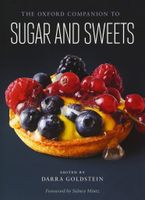Advertisement
Romantic Sweets
Published 2015
From the eighteenth century on, upper-class women in France and England, as well as in other European countries, gathered in elegant cafés and consumed pastries with their beverages. They also patronized refined confectionery shops whose décor and service catered to the taste of the female clientele. As sugar became more available and its price fell, working-class women were able to add sugar or molasses to their tea, while upper-class women turned more to candies and dainty chocolate. See chocolate, luxury and chocolates, boxed. Sweets came to symbolize men’s romantic interest in women, a custom that continues today on Valentine’s Day and, to a lesser extent, on Mother’s Day. See valentine’s day. Romantic messages were at times wrapped in paper that carried amorous messages, a peculiarity that is still found in Italian Baci chocolates. The connection between desserts and courtship was reflected also in the popularity of wedding cakes, larger and more spectacular than those used on other occasions, probably an echo of the stunning cakes consumed during noble banquets when sugar was still a luxury. See wedding cake.


